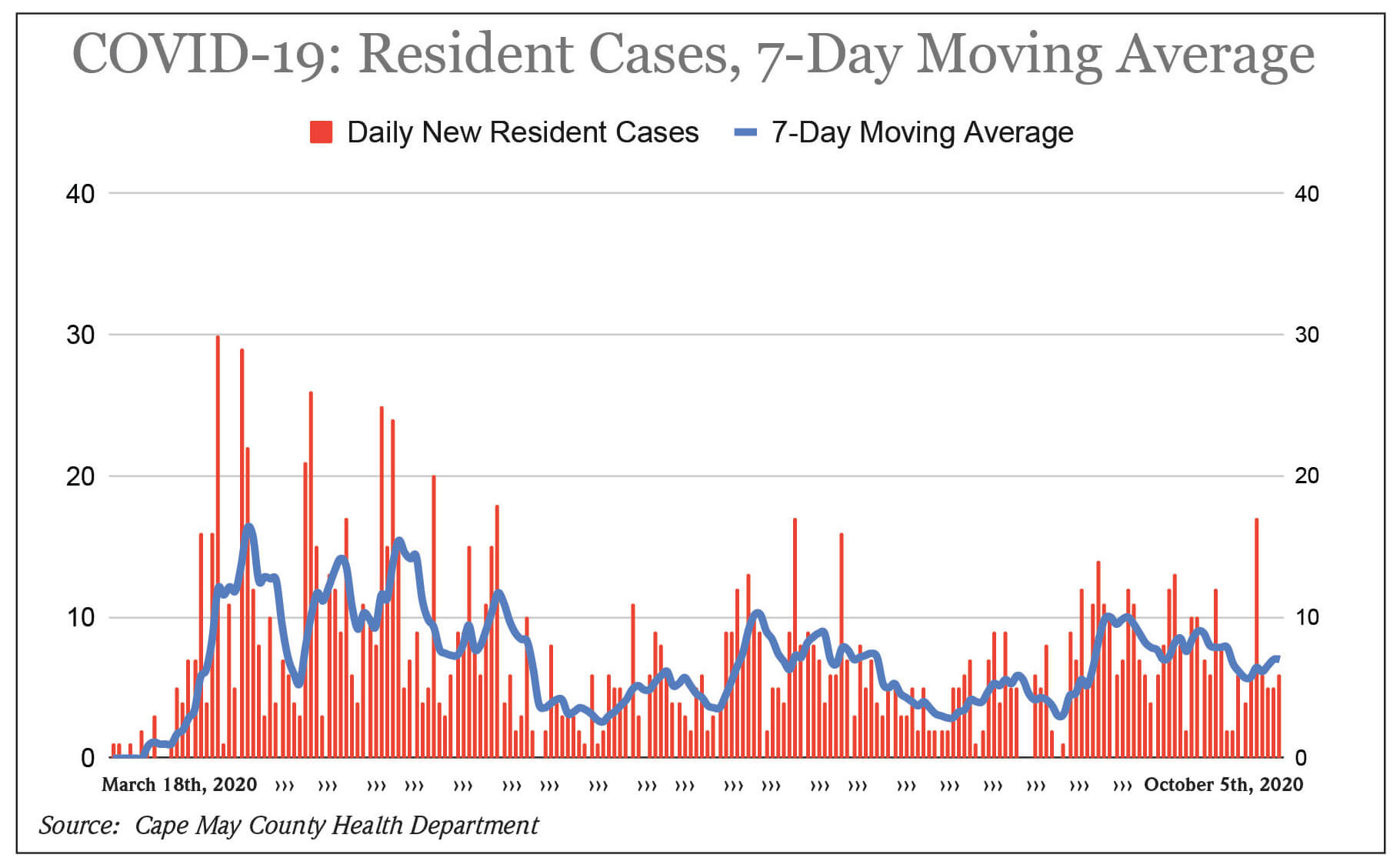To access the Herald’s local coronavirus/COVID-19 coverage, click here.
COURT HOUSE – “Events seem to be getting more intense,” Gov. Phil Murphy said Oct. 5, regarding the newest COVID-19 numbers.The state, this week, experienced nearly 5,000 new cases of COVID-19 infection over seven days. There were 957 new positive tests among state residents Oct. 3, the highest single-day total since May.
It is worth looking at the state problem and returning to Cape May County’s numbers.
“Hot spots” are driving the state’s spike, with Ocean County as the hottest of them. The state Oct. 5 announced 522 new cases for the last 24 hours, noting that 119 were from Ocean County; 86 of the Ocean County cases were from Lakewood. In the past few weeks, Ocean County accounted for as much as 40% of the state’s single-day total.
In some of the last several weeks, the outbreak, in Ocean County, showed positivity rates that would’ve placed the county, if it was a state, on New Jersey’s travel advisory list. For the record, Ocean County has a larger population than Wyoming.
State Health Commissioner Judith Persichilli said the state positivity rate at the end of the week was 2.62%. That rate was 2.18% in the northern counties; 3.30% in the central counties 3.30%; and 2.56% in the southern counties.
In Ocean County, the rate reduced to 7.5%, with Lakewood seeing its rate decline from 28% to 19.5%. That rate implies that, in Lakewood, one out of every five tests is positive, even with the decline.
For those watching the key health metrics, the rate of transmission for the state remains above the desired threshold. At the end of the week, it was 1.27, a level with which health officials were not happy.
In Cape May County, there was moderate growth in the new case numbers this week. Cape May County Health Department reported 49 resident cases and 15 non-resident cases, for a total of 64. The prior week saw 43 resident cases and three non-resident cases, for a total of 46.
The difference in the two weeks was a single-day report of 17 new resident cases Oct. 1. Almost immediately after that jump, the number returned to the usual pace of around six new resident cases per day.
Anecdotal evidence says that one reason the county continues to see large numbers of people is the perception that this is a safer place to wait out the virus.
That perception is also partly because the county experienced only four new fatalities since Sept. 1, even though the total of new cases for September was higher than any month since May. The county had more new resident cases, in September, than in any of the three months since May.
The difference between the actual reported numbers and the “feeling” of relative safety is due to both greater growth in infections outside the county and the lack of daily reports of deaths from the infections. Those reports of deaths characterized the pandemic’s earlier months. The county experienced an average of one death per day, in May, which was 30 fatalities in 31 days.
The difference, according to the Centers for Disease Control and Prevention, is, what state epidemiologist Dr. Tina Tan calls, the demographic shift in the victims of infection.
In the spring, the county experienced numerous outbreaks at long-term care facilities, which housed individuals extremely vulnerable to serious complications. Deaths multiplied.
Despite climbing cases, the demographic predominating in the positive tests is younger. The highest group in one New Jersey hot spot is among those 30-49 years old, the second highest is those 18-29.
Fatigue with protective protocols after six months, an economy in great difficulty, and a seemingly less lethal virus, even with rising infections, adds to a relaxing of precautions.
The media adds to the confusion with its heavy focus on mortality numbers, leading some to the belief that if the odds of dying are lessening, the pandemic is winding down in its cruelty if not in its numbers.
Scientists and health officials tried to combat what they see as a misperception by trying to get more attention placed on the long-term effects of COVID-19 infection for those who survive. The virus, they say, is not only dangerous for the old, obese, hypertensive and diabetic.
A term surfaced for those who suffer from a long list of maladies after they have beaten the virus that attempted to kill them. They are called the “long-haulers.”
Studies are stressing the long-term impact of the virus on the lungs, heart, kidneys and brain. For some of these, impacts will reverse themselves. For others, they won’t.
The case of corrections officer Chris Stanek serves as an example of the tremendous toll a battle with COVID-19 can entail, even for a survivor. Hospitalized or in rehabilitation for 111 days, Stanek, from Cumberland County, was on a ventilator twice and was seldom without the fear of death from the disease.
This county has, so far, been blessed with a relatively light health blow. The numbers are doing well, although they are probably higher than people “sense” they are.
Eighty milesnorth is acounty struggling with a major outbreak. The long-term impact of that outbreak is unknown. It’s better to be in Cape May County and to do what is needed to keep it a better place.
To contact Vince Conti, email vconti@cmcherald.com.








